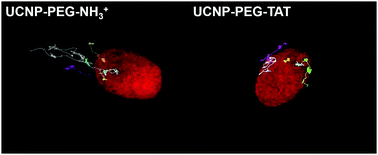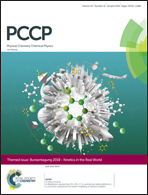Cellular uptake efficiency of nanoparticles investigated by three-dimensional imaging†
Abstract
Understanding the interaction of nanoparticles with living cells on the basis of cellular uptake efficiency is a fundamental requisite in biomedical research. Cellular internalization of nanoparticles takes place by mechanisms like ATP hydrolysis-driven endocytosis that deliver nanoparticles to the cytoplasm, organelles and nuclei. Despite its importance in nanomedicine, this uptake procedure is not understood in-depth because of the complexity of the biochemical mechanisms and the lack of available experimental methods for quantitative analysis. The only breakthrough is likely to be the development of imaging techniques that can visualize, monitor and even count the number of nanoparticles inside the cell. To this end, we report here a new, fast and background-free three-dimensional (3-D) imaging technique with quantitative evaluation of the uptake efficiency for NaYF4:Yb3+,Er3+/NaYF4 core/shell upconversion nanoparticles (UCNPs) functionalized with different chemical and biological groups. Furthermore, the multiple 3-D trajectories of the UCNPs have been analyzed to investigate the cellular dynamics. This study reveals the nuclear uptake of UCNPs to be dependent on the specific chemical groups conjugated to the UCNPs. The developed 3-D imaging technique is of great significance for exploring complex biological systems.



 Please wait while we load your content...
Please wait while we load your content...